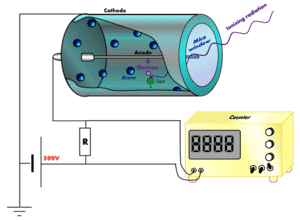In the Geiger-Muller tube, particles ionize gas atoms. The tube contains a gas at low pressure. At one end of the tube is a very thin “window”
through which charged particles or gamma rays pass. Inside the tube is a copper cylinder with a negative charge. A rigid wire with a positive charge runs down the center of this cylinder. The voltage across the wire and cylinder is kept just below the point at which a spontaneous discharge, or spark, occurs. When a charged particle or gamma ray enters the tube, it ionizes a gas atom between the copper cylinder and the wire. The positive ion produced is accelerated toward the copper cylinder by the potential difference. The electron is accelerated toward the positive wire. As these new particles move toward the electrodes, they strike other atoms and form even more ion in their path.
Thus an avalanche of charged particles is created and a pulse of current flows through the tube. The current causes a potential difference across a resistor in the circuit. The voltage is amplified and registers the arrival of a particle by advancing a counter or producing an audible signal, such as a click. The potential difference across the tube so that the current flow stops. Thus the tube is ready for the beginning of a new avalanche when another particle or gamma ray enters it

